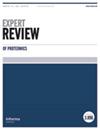Unraveling the complexity of the extracellular vesicle landscape with advanced proteomics
IF 3.8
3区 生物学
Q1 BIOCHEMICAL RESEARCH METHODS
引用次数: 6
Abstract
ABSTRACT Introduction The field of extracellular vesicles (EVs) is rapidly advancing. This progress is fueled by the applications of these agents as biomarkers and also as an attractive source to encapsulate therapeutics. Areas covered Different types of EVs, including exosomes, and other nanoparticles have been identified with key regulatory functions in cell–cell communication. However, the techniques used for their purification possess inherent limitations, resulting in heterogeneous preparations contaminated by other EVs subtypes and nano-size structures. It is therefore urgent to deconvolute the molecular constituents present in each type of EVs in order to accurately ascribe their specific functions. In this context, proteomics can profile, not only the lumen proteins and surface markers, but also their post-translational modifications, which will inform on the mechanisms of cargo selection and sorting. Expert opinion Mass spectrometry-based proteomics is now a mature technique and has started to deliver new insights in the EV field. Here, we review recent developments in sample preparation, mass spectrometry (MS) and computational analysis and discuss how these advances, in conjunction with improved purification protocols, could impact thecharacterization of the complex landscape of EVs and other secreted nanoparticles.用先进的蛋白质组学揭示细胞外囊泡景观的复杂性
细胞外囊泡(EVs)领域正在迅速发展。这一进展是由这些药物作为生物标志物的应用以及作为封装治疗药物的有吸引力的来源而推动的。不同类型的ev,包括外泌体和其他纳米颗粒已被确定在细胞-细胞通讯中具有关键的调节功能。然而,用于其纯化的技术具有固有的局限性,导致非均质制剂被其他ev亚型和纳米级结构污染。因此,迫切需要解卷积存在于每种类型的电动汽车中的分子成分,以便准确地归因于它们的特定功能。在这种情况下,蛋白质组学不仅可以分析管腔蛋白和表面标记物,还可以分析它们的翻译后修饰,这将为货物选择和分选机制提供信息。基于质谱的蛋白质组学现在是一项成熟的技术,并开始在EV领域提供新的见解。在这里,我们回顾了样品制备、质谱分析和计算分析方面的最新进展,并讨论了这些进展如何与改进的纯化方案相结合,影响电动汽车和其他分泌纳米颗粒复杂景观的表征。
本文章由计算机程序翻译,如有差异,请以英文原文为准。
求助全文
约1分钟内获得全文
求助全文
来源期刊

Expert Review of Proteomics
生物-生化研究方法
CiteScore
7.60
自引率
0.00%
发文量
20
审稿时长
6-12 weeks
期刊介绍:
Expert Review of Proteomics (ISSN 1478-9450) seeks to collect together technologies, methods and discoveries from the field of proteomics to advance scientific understanding of the many varied roles protein expression plays in human health and disease.
The journal coverage includes, but is not limited to, overviews of specific technological advances in the development of protein arrays, interaction maps, data archives and biological assays, performance of new technologies and prospects for future drug discovery.
The journal adopts the unique Expert Review article format, offering a complete overview of current thinking in a key technology area, research or clinical practice, augmented by the following sections:
Expert Opinion - a personal view on the most effective or promising strategies and a clear perspective of future prospects within a realistic timescale
Article highlights - an executive summary cutting to the author''s most critical points.
 求助内容:
求助内容: 应助结果提醒方式:
应助结果提醒方式:


